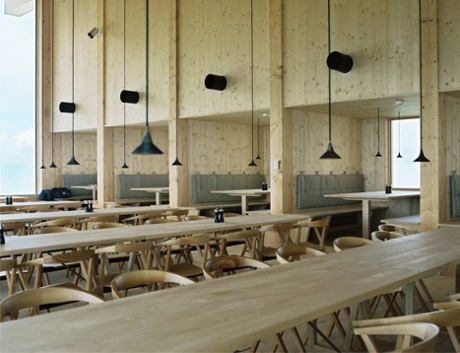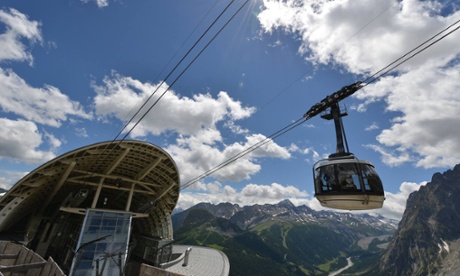
Andrew Todd, The Guardian, October 21, 2015
This year is the 150th anniversary of the conquest of the Alps’ last major peaks, including the Grandes Jorasses and the Matterhorn – the culmination of a five-year flurry of Alpine first ascents. While these feats are being celebrated throughout the winter in a number of fascinating exhibitions, particularly in the Chamonix valley, it perhaps sounds odd now to talk of “conquests” in relation to nature. We have – sadly – effectively conquered her, and are awaiting the blowback of climate change: mountains are crumbling at alarming rates, glaciers are receding, whole valleys are being cut off by landslides. But a new, gentle approach to the high mountains is in evidence in a range of recent buildings that give both expert climbers and the general public the chance to understand these changes without leaving a heavy footprint. Some are remote, cutting-edge, autonomous, space-age pods accessed only by risky ascents in technical gear; others you can go and see in your flip-flops.
Refuge du Gouter, Mont Blanc, France
In the frenzied early period of Alpine exploration (and exploitation) the biggest target of all was the mighty Mont Blanc, an inhospitable wilderness in the heart of Europe culminating at 4,808 metres, which was conquered in 1786.
The mountain shrugged off early attempts at development. Gustave Eiffel, not content with looming over Paris, attempted to dig the foundations for a lodge and observatory right at the summit. Scientist Joseph Vallot had more luck 500 metres lower down and installed – as you do – a lush oriental salon in his shelter (you can see it reconstituted in the Chamonix Alpine Museum).

A resconstruction of Joseph Vallot’s oriental salon in the Chamonix Alpine Museum
The magnificent new Refuge du Gouter, opened last year, stands in sharp contrast to this peak-bagging, colonial attitude: it is space-age eco-architecture, a uniquely beautiful and intelligent building, inside and out. The former refuge – sealed shut awaiting its fate – is a pock-marked metal shed sitting on shifting ice. In use, it was sub-par and often terribly overcrowded.

The new refuge is built further along the precipice of the Aiguille du Gouter (the crumbling rock face that kills many climbers every year). It is a steel-clad wooden egg perched over the void on steel piles drilled six metres into the mountain, turning its nose to the prevailing wind and plastered in photovoltaic panels. Inside it is warm and minimalist, its chunky wooden frame complemented by pine benches, bunks and floors. The climbers’ bunk rooms – with wooden screens between the beds – are a vast improvement on the old refuge’s haphazard heap of bodies; food is also good and hearty, and the common areas are light and panoramic. Its heart is a submarine-like plant room regulating meltwater for consumption, storing electricity in huge batteries and compacting excrement for helicopter evacuation.
• Half-board stay in dorm bed €93pp, refugedugouter.ffcam.fr. Getting to the refuge involves an exposed scramble up the Aiguille du Gouter, including the notorious Grand Couloir, which is subject to frequent rockfall; a guide is necessary. The Refuge is open June-late September or early October, and can close when the ascent becomes dangerous (sometimes for weeks). Check the website before travelling; reservations are essential. A spartan emergency bivouac adjacent to the old refuge is open all year round
Chässerug, Toggenburg, Switzerland

The challenge of designing responsibly for the mountains has attracted superstar Tate Modern architects Herzog and de Meuron to the relatively modest job of renovating a cable car station. Inaugurated in June this year and open all year round (with some inter-season closure), the Chässerug lift station sits on a plateau above the 2,000-metre precipice bordering the north side of the Walensee, about an hour from Zurich by car or train and bus. It offers a superb panorama over six countries and gives access to extensive summer and winter hiking and winter skiing.

Chässerug station’s new canteen, made from local spruce. Photograph: https://www.facebook.com/chaeserrugg/photos_stream
Replacing a jerry-built canteen formerly on the site, the new building is sober, rugged and sensual, made entirely of locally sourced and crafted spruce – a far cry from the fake chalets that offer overpriced, mass-produced meals to hordes of skiers. The food here is well-executed local fare made with fresh, responsibly sourced ingredients (three courses from about £20). Building on such a remote site required great ingenuity – here the timbers we brought in using the existing cable car instead of by not-so-eco helicopters.
• Adult ticket £33 return, including lunch, chaeserrugg.ch. Restaurant open all year except weekdays in October-November (weekend opening dependent on weather, winter opening according to snowfall, check the website). The lower lift station in Unterwasser is open 8.30am-5pm (winter hours).
Hotel Bellevue, les Houches, France

If you don’t want to brave the climate change-accelerated rockfall on the Aiguille du Gouter, ponder the projecting egg of the new refuge from the place where early climbers would eye up the normal route up Mont Blanc. On the site of a stone-built 1868 establishment of the same name, the new Hotel Bellevue is another piece of pioneering eco-architecture from the great Austrian architect Hermann Kaufmann. Made from robot-milled wood, the building uses 10% of the energy of a conventional building thanks to geothermal energy, and high-spec insulation. The only hitch is that this exemplary building has been shut for the three years since it was finished because of a stand-off between the government and the owner, which is now trundling through the courts. It may open with some modifications: until them, enjoy looking at it from nearby Hotel Le Prarion.
• Projected rate from €210 half-board for two, bellevuemontblanc.com. The hotel is accessible from the Bellevue ski lift from Les Houches or the nearby Tramway du Mont Blanc from Saint Gervais les Bains station. (This is a rack-and -pinion train rather than a tram, and runs to the start of the Aiguille du Gouter ascent at the Nid d’Aigle viewpoint).
Skyway Monte Bianco and Rifugio Torino, Italy

The Skyway’s panoramic cars revolve as they ascend. Photograph: https://www.facebook.com/skywaymontebianco
The Italian side of Mont Blanc is more spectacular than the Chamonix one: the mountain cascades right down to the valley in a series of forbidding crags and needles. The geography means the site is also much less developed, although it does see heavy traffic from the tunnel under the mountain. A new, wonderful piece of civic infrastructure, Skyway Monte Bianco could open up the mountain’s southern side to mass tourism, whisking visitors to Punta Helbronner at 3,452 metres on the French border in a few minutes. The Skyway, inaugurated in June this year by Italian prime minister Matteo Renzi (“We’re not invading France,” he declared at the time) replaces the old La Palud cable car. This resembled a 1950s Paris Metro carriage, and trembled as it climbed, its door secured only with a brass latch.
The Skyway’s bulbous panoramic cars are glazed right to the floor, and revolve as they ascend. Easy to access directly from the tunnel road, the Skyway is a destination in itself for those who don’t want to strap on crampons. A mid-station features one of Europe’s highest Alpine gardens, a gift shop selling local produce, and a 150-seat conference room, a restaurant and even a winery, using grapes from the valley below.
Some local guides grumble that such fripperies have no place in the high mountains, and the decor is more shopping mall than eco-lodge: I felt out of place here, sweaty and bedraggled after a long schlepp from the Grand Capucin, a mythical granite spire the other side of the Glacier du Géant.
The vertiginous summit station is topped with a panoramic platform which gives a thrilling proximity to Mont Blanc’s mighty Brenva face, the spiny Dent du Géant and the vast bowl of the Vallée Blanche. The top station is bravura engineering: a jagged glass -and-steel carapace (with a very decent cafeteria), rooted in an 80-metre spine through the rock. The spine contains a lift shaft conveying more adventurous visitors to a chilly tunnel leading out on to the glacier and to the restored Torino Hut (where, from spring 2016, visitors will be able to spend a comfy night and watch a spectacular dawn over the Aosta valley).
The Glacier du Géant is perfect for non-vertiginous trekking in a spectacular setting (a guide is necessary, as are crampons and ropes); it’s also an easier start than the precipitous Aiguille du Midi for the 13km Vallée Blanche ski run. Things can be deceptive, though: on 27 August, a 40,000-tonne chunk of the Tour Ronde collapsed suddenly, obliterating the path I had sauntered along a few weeks previously. It’s perhaps important that – thanks to the Skyway – tourists in flip-flops can directly witness such harbingers of climate change.
• Skyway: return to Punta Hellbronner €43pp, montebianco.com, open all year round 8.30am-4.35pm in winter. Torino Hut: €70pp full-board, rifugiotorino.com. Check website for opening and booking details: hut managers tend to be independent-minded.
Monte Rosa Hutte, Switzerland

National borders wiggle invisibly over summits and precipices: trudging breathlessly up Mont Blanc’s final arête, you won’t care that your right foot is in Italy and your left in France. But if you thought such an extreme environment would reduce architecture to a survivalist standardisation, you’d be wrong: even the remotest places, it seems, reflect national character. In Italy, burly, swarthy bergamaschi builders romp fearlessly across the snow as they work on the Torino Hut, whereas over the hill, French workers are diligently, carefully decommissioning the asbestos-infested old Refuge du Gouter. There’s even been some Alpine umbrage regarding the generous European funding of the Skyway: the French have yet to build their part of the path leading up to the spectacular exit at the top station, effectively closing the Schengen border between caffè ristretto and café allongé.
Trust the Swiss, then, to be the smartypants with the deepest pockets in this mountain brinksmanship. The new Monte Rosa Hutte, stranded like a crashed UFO on a rock in the middle of the vast Gorner glacier, is an emblem of Helvetic pride, having been conceived with the Federal Institute of Technology in Zurich, and rather more lavishly funded (for the same capacity) than the Gouter hut. Open since 2010, 1,000 metres lower than its cousin on Mont Blanc, it uses some of the same approaches to eco-building (wood frame, tight volume, metal skin, abundant photovoltaics), with extras including a vast grotto blasted into the rock to store meltwater. It is the most complex wooden building ever made in Switzerland, and throws some demonstrative Daniel Libeskindian shapes, with its jagged stair glazing, where the French hut remains impassively rational in its eggy geometry.
The location is different, too: the Monte Rosa Hutte sits at a hub of many climbs rather than on a highway with one destination, and can be accessed with relatively little danger (albeit with some ladders and a glacier crossing, which may require ropes and crampons). Where the Gouter hut keeper has to get used to his guests leaving en masse at 3am – with absolutely no desire for a return trip – the Monte Rosa Hutte incites a relaxing, contemplative stay in an utterly extraordinary setting.
• Dorm bed £64pp half-board, including take-away hikers’ tea, section-monte-rosa.ch. Reservation essential. Open June-October, depending on weather conditions.
Accommodation was provided by the Office de Tourisme de Chamonix and the Club Alpin Français provided guiding to Refuge du Gouter
This article originally appeared on guardian.co.uk
This article was written by Andrew Todd from The Guardian and was legally licensed through the NewsCred publisher network.
![]()